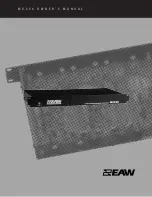
Quad-Core Intel® Xeon® Processor 5300 Series Datasheet
79
Signal Definitions
5
Signal Definitions
5.1
Signal Definitions
Table 5-1.
Signal Definitions (Sheet 1 of 7)
Name
Type
Description
Notes
A[37:3]#
I/O
A[37:3]# (Address) define a 2
38
-byte physical memory address space. In sub-phase
1 of the address phase, these signals transmit the address of a transaction. In sub-
phase 2, these signals transmit transaction type information. These signals must
connect the appropriate pins of all agents on the FSB. A[37:3]#
4
are protected by
parity signals AP[1:0]#. A[37:3]#
4
are source synchronous signals and are latched
into the receiving buffers by ADSTB[1:0]#.
On the active-to-inactive transition of RESET#, the processors sample a subset of the
A[37:3]#
4
lands to determine their power-on configuration. See
Section 7.1
.
3,4
A20M#
I
If A20M# (Address-20 Mask) is asserted, the processor masks physical address bit 20
(A20#) before looking up a line in any internal cache and before driving a read/write
transaction on the bus. Asserting A20M# emulates the 8086 processor's address
wrap-around at the 1 MB boundary. Assertion of A20M# is only supported in real
mode.
A20M# is an asynchronous signal. However, to ensure recognition of this signal
following an I/O write instruction, it must be valid along with the TRDY# assertion of
the corresponding I/O write bus transaction.
2
ADS#
I/O
ADS# (Address Strobe) is asserted to indicate the validity of the transaction address
on the A[37:3]#
4
lands. All bus agents observe the ADS# activation to begin parity
checking, protocol checking, address decode, internal snoop, or deferred reply ID
match operations associated with the new transaction. This signal must be connected
to the appropriate pins on all Quad-Core Intel® Xeon® Processor 5300 Series FSB
agents.
3
ADSTB[1:0]#
I/O
Address strobes are used to latch A[37:3]#
4
and REQ[4:0]# on their rising and falling
edge. Strobes are associated with signals as shown below.
3,4
AP[1:0]#
I/O
AP[1:0]# (Address Parity) are driven by the request initiator along with ADS#,
A[37:3]#
4
, and the transaction type on the REQ[4:0]# signals. A correct parity signal
is high if an even number of covered signals are low and low if an odd number of
covered signals are low. This allows parity to be high when all the covered signals are
high. AP[1:0]# must be connected to the appropriate pins of all Quad-Core Intel®
Xeon® Processor 5300 Series FSB agents. The following table defines the coverage
model of these signals.
3,4
BCLK[1:0]
I
The differential bus clock pair BCLK[1:0] (Bus Clock) determines the FSB frequency.
All processor FSB agents must receive these signals to drive their outputs and latch
their inputs.
All external timing parameters are specified with respect to the rising edge of BCLK0
crossing V
CROSS
.
3
Signals
Associated Strobes
REQ[4:0], A[16:3]#,
A[37:36]#
4
ADSTB0#
A[35:17]#
ADSTB1#
Request Signals
Subphase 1
Subphase 2
A[37:24]#
4
AP0#
AP1#
A[23:3]#
AP1#
AP0#
REQ[4:0]#
AP1#
AP0#
Summary of Contents for Quad-Core Xeon
Page 1: ...Order Number 315569 003 Quad Core Intel Xeon Processor 5300 Series Datasheet September 2007...
Page 8: ...8 Quad Core Intel Xeon Processor 5300 Series Datasheet...
Page 54: ...Mechanical Specifications 56 Quad Core Intel Xeon Processor 5300 Series Datasheet...
Page 84: ...Signal Definitions 86 Quad Core Intel Xeon Processor 5300 Series Datasheet...















































